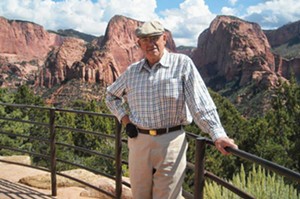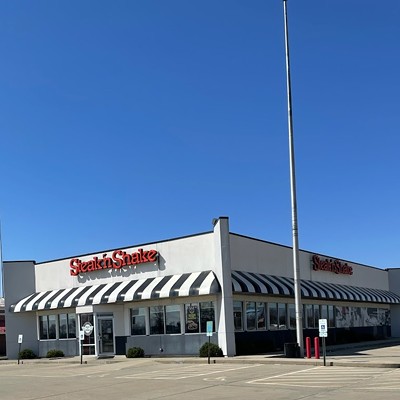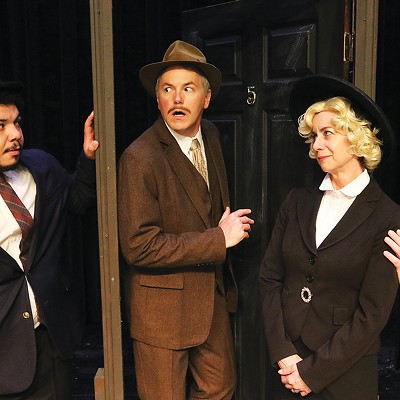Explosions ripped the air as a demolition team set off charges to bring down the Sankey high-rise apartments a few blocks east of Washington Park. Then silence. But no crash.
As smoke from explosives cleared on Oct. 22, 2013, both 14-story towers remained in place. It took 10 minutes for the first one to fall. The second stood for hours. While nearby residents made plans to spend the night elsewhere, while demolition experts scratched their heads, while reporters stood watch and the city collectively wondered “what now?” Robert Evans celebrated.
“He was absolutely crowing,” recalls Don Evans, son of the late head of Evans Construction, which built the towers and scores of other Springfield landmarks. “He was saying, ‘They underestimated the quality of buildings that Evans can put together.’”
The second tower finally tumbled, eight hours behind schedule and long after nightfall. A spokeswoman for the demolition company blamed – or credited – a “very sturdy” exterior wall for the unforeseen delay in converting the 45-year-old tower to rubble. Don Evans says it wasn’t unusual for the company to use more steel than recommended.
“He was proud of the fact that we do some extra steps in our buildings,” Don Evans said.
Evans Construction was started by Robert Evans’ grandfather in 1913. At first, the company concentrated on residential and light commercial construction, but it didn’t take long to get huge. In 1929, the firm began construction on the 15-story Illinois Building at 607 E. Adams St., which was the tallest in the city when it was completed in 1931. Made with plenty of stone and marble and lit up by floodlights at night, the building turned heads, and there was no going back for the company.
The Old State Capitol. The Illinois State Library. Southeast High School. The Horace Mann building. It is difficult to go anywhere in Springfield without seeing a can’t-miss-it building that Evans Construction erected while Robert Evans was calling the shots. After a stint in the Army and two years at the University of Illinois, he went to work at the family-owned firm and became a co-owner in the 1950s. He retired at the end of 1997.
“He really had an eye for just being able to look at a job site and being able to evaluate it, whether things were going well or not just by watching for a short period of time,” Don Evans recalls. “The construction business is a living, breathing animal. There’s always challenges in a project. He just dealt with it. He always came up with a solution. … He was pretty even-tempered as far as managing the projects, being involved with projects. He didn’t really let things upset him.”
Growing up, Don Evans always had a job, but it wasn’t cushy, he recalls. In high school, he played on the golf team and once considered skipping work to concentrate on his game.
“That didn’t go over too well,” Don Evans recalled. “He said ‘If you want to golf, go ahead and golf, but don’t come back to work.’”
Don Evans says he worked as a laborer, typically sweeping up messes left by others and hauling concrete in two-wheeled pushcarts called Georgia buggies.
“I do remember he expected me to work, not just be the kid with the silver spoon that gets put on the job and these workers have to deal with me,” Don Evans says. “He said ‘I’m going to give you an opportunity. If the superintendent doesn’t think you’re a hard worker, he has the ability to fire you.’”
Don Evans said his father could build things himself as well as direct others. He was also a tinkerer with a passion for woodworking and PVC pipe.
Over the years, Robert Evans made scores of contraptions from PVC pipe – a chair, a table, a doohickey that allowed his dog with a bum hip to get in the back of his truck on its own.
“It was never as strong as he wanted it to be – a lot of times, he would take a metal pipe and put it inside the PVC to strengthen it up,” Don Evans said. “In the last days, when he was having a hard time getting around, his bedroom was full of these little PVC contraptions that he made. He used them to support himself, to get in and out of the bedroom and move around.”
Robert Evans died from cancer that started in his colon and spread to his liver and lungs before it was detected.
“He was actually an overachiever in that, too,” Don Evans said. “He fought it, did all the chemo and radiation treatments and he lasted almost a year and a half. … I remember telling him, I said I was proud of him for how he was handling the cancer. His comment was, he was proud of us, too. Never complained at all.”
Contact Bruce Rushton at [email protected].
The builder
ROBERT L. EVANS March 5, 1935-Nov. 8, 2015
[
{
"name": "Air - MedRect Combo - Inline Content 1",
"component": "11490391",
"insertPoint": "3",
"requiredCountToDisplay": "1",
"parentWrapperClass": "fdn-ads-inline-content-block"
},{
"name": "Air - MedRect Combo - Inline Content 2",
"component": "11490392",
"insertPoint": "7",
"requiredCountToDisplay": "5",
"parentWrapperClass": "fdn-ads-inline-content-block"
},{
"name": "Air - MedRect Combo - Inline Content 3",
"component": "11490393",
"insertPoint": "12",
"requiredCountToDisplay": "9",
"parentWrapperClass": "fdn-ads-inline-content-block"
}
]
Boom! Boom! Boom!
Illinois Times has provided readers with independent journalism for almost 50 years, from news and politics to arts and culture.
Your support will help cover the costs of editorial content published each week. Without local news organizations, we would be less informed about the issues that affect our community..
Got something to say?
Send a letter to the editor and we'll publish your feedback in print!






















